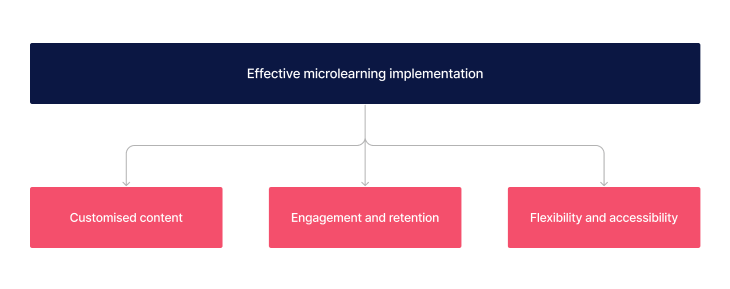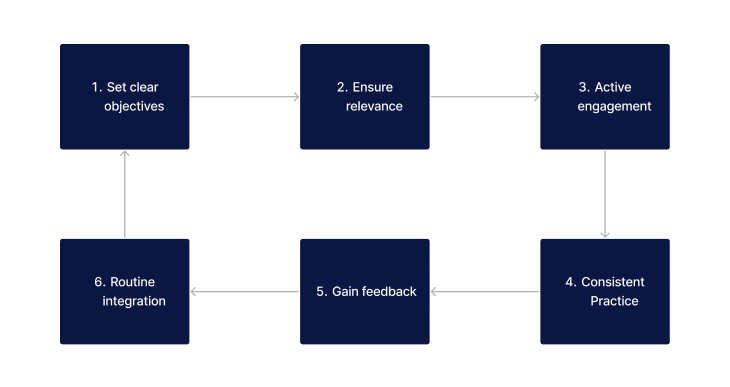The healthcare sector constantly seeks innovative ways to enhance education and training. Amidst evolving methodologies, microlearning has gained prominence, especially for its adaptability and efficiency. This article explores the concept of microlearning, its application in healthcare education, and practical guidance on its effective implementation.
What is Microlearning?
Microlearning refers to an educational approach involving the delivery of content in concise, focused segments. It's especially suitable for the healthcare sector due to its cost-effectiveness and compatibility with the demanding schedules of healthcare professionals (HCPs) (Almanac, n.d.; EdApp, n.d.).
What's the Role of Microlearning in Healthcare Education
The advent of microlearning in healthcare education, especially post-COVID-19, has been significant. It's highly engaging, succinct, and easy to digest, helping learners maintain high engagement and avoid mental fatigue. For healthcare professionals, microlearning is a convenient way to access and digest educational material, fitting learning into their busy schedules (Almanac, n.d.).
What Types of Microlearning Are There?
Microlearning comes in various forms, each serving unique purposes:
- Contextual Learning: This method enhances learning by aligning content with real-life scenarios (EdApp, n.d.).
- On-Demand Access: Accessibility is crucial, allowing learners to access content when needed, particularly on mobile devices (EdApp, n.d.).
- Data Collection: This aspect helps identify professional skill gaps for targeted training (EdApp, n.d.).
Examples of Microlearning in Healthcare
Practical examples showcase microlearning's effectiveness:
- Programs like “Sweet 16: Time to Complete Meningococcal Vaccines” demonstrate microlearning's application in tackling healthcare challenges (Almanac, n.d.).
- Microlearning videos in healthcare facilities can reduce patient no-show rates by educating them about procedures (EdApp, n.d.).
How to Perform Microlearning

Effective microlearning implementation includes:
- Flexibility and Accessibility: Creating short, accessible modules to fit healthcare workers' schedules (Trainizi, n.d.).
- Engagement and Retention: Using interactive content to enhance engagement and knowledge retention (Trainizi, n.d.).
- Customised Content: Tailoring modules to specific healthcare roles and tasks ensures relevancy and effectiveness (Trainizi, n.d.).
What are the Considerations for Microlearning in Healthcare
Key factors to consider in microlearning include:
- Adapting to Healthcare Changes: Regularly updating content to reflect current healthcare practices and protocols (Trainizi, n.d.).
- Role-Specific Content: Developing content tailored to the unique needs of various healthcare roles (Trainizi, n.d.).
What are the Benefits and Negatives of Microlearning
Microlearning offers several advantages but also has its limitations:
| Benefits | Negatives |
|---|---|
| Enhanced Knowledge Retention: Its concise format aids in better information retention, crucial in healthcare (Almanac, n.d.). | Surface-Level Understanding: Microlearning might lead to a superficial grasp of complex subjects, lacking depth. |
| Increased Engagement: The interactive nature keeps learners involved, enhancing learning (Trainizi, n.d.). | Limited Scope for Discussion: The format may not allow for in-depth discussions or peer interactions. |
| Cost-Effectiveness: Being economical and quick to develop, it's a practical option for healthcare organisations (EdApp, n.d.). | Overreliance on Technology: Dependence on digital platforms could be a barrier for less tech-savvy learners. |
| Flexibility: The method fits well with healthcare professionals' varied schedules (Trainizi, n.d.). | Potential for Fragmented Learning: There's a risk of fragmented learning experiences without a cohesive structure. |
| Personalised Learning: Customisation ensures relevant and effective training for different roles (Trainizi, n.d.). | |
| Efficient Time Use: Addresses the challenge of limited learning time, offering brief sessions (Almanac, n.d.). |
Want a healthcare LMS that can support microlearning?
Contact Ausmed today and see how we can support your organisation!
How to Become Good at Microlearning

To become good at microlearning, consider the following steps and actions:
- Set Clear Objectives: Define specific goals for each module.
- Relevance: Ensure content applicability to daily tasks.
- Active Engagement: Encourage interaction with the material.
- Consistent Practice: Engage regularly with modules.
- Feedback: Seek and incorporate feedback.
- Routine Integration: Embed microlearning into daily routines.
Implementing Microlearning in Healthcare Settings
Effective implementation requires:
- Identify Objectives: Establish clear learning outcomes.
- Engaging Content: Develop interactive, relevant content.
- Accessibility: Ensure ease of access on various devices.
- System Integration: Seamlessly incorporate into existing systems.
- Evaluation: Continuously assess and adjust the modules.
- Continuous Learning: Promote ongoing learning opportunities.
Related Resources
- LMS in Healthcare: The Roles, Benefits and Pros and Cons
- Guide to Mandatory Training
- How Do I Align Training Programs with Organisational Goals?
- How to Perform Post-Training Assessments
- Guide to Compliance Training (for Healthcare Managers)
- How Can I Implement Self-Directed Learning Strategies?
- How Can Organisations Create a Learning Culture that Attracts Amazing People?
- How to Manage an Effective Staff Training Program
- Research Spotlight: Motivation for Self-directed Training
Conclusion
Microlearning represents a shift towards dynamic, effective learning methods in healthcare education. Its ability to provide targeted, relevant content and improve knowledge retention makes it a vital tool for healthcare professionals' education and development.
References
- Almanac. (n.d.). Microlearning: Bite-sized Education for the Busy Healthcare Professional. Retrieved from https://almanac.acehp.org
- EdApp. (n.d.). Microlearning In Healthcare Industry Training. Retrieved from https://www.edapp.com
- Trainizi. (n.d.). Empowering Healthcare Workers with Microlearning. Retrieved from https://www.trainizi.com



